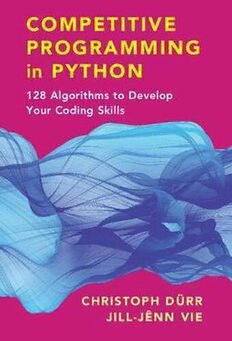Table Of ContentCompetitiveProgramminginPython
Want to kill it at your job interview in the tech industry? Want to win that coding
competition? Learn all the algorithmic techniques and programming skills you need
fromtwoexperiencedcoaches,problem-setters,andjudgesforcodingcompetitions.
The authors highlight the versatility of each algorithm by considering a variety of
problemsandshowhowtoimplementalgorithmsinsimpleandefficientcode.What
toexpect:
* Master128algorithmsinPython.
* Discovertherightwaytotackleaproblemandquicklyimplementasolutionoflow
complexity.
* Understand classic problems like Dijkstra’s shortest path algorithm and
Knuth–Morris–Pratt’sstringmatchingalgorithm,pluslesser-knowndatastructures
likeFenwicktreesandKnuth’sdancinglinks.
* Developaframeworktotacklealgorithmicproblemsolving,including:Definition,
Complexity,Applications,Algorithm,KeyInformation,Implementation,Variants,
InPractice,andProblems.
* Pythoncodeincludedinthebookandonthecompanionwebsite.
Christoph Dürr is a senior researcher at the French National Center for Scientific
Research (CNRS), affiliated with the Sorbonne University in Paris. After a PhD in
1996atParis-SudUniversity,heworkedforoneyearasapostdoctoralresearcherat
the International Computer Science Institute in Berkeley and one year in the School
of Computer Science and Engineering in the Hebrew University of Jerusalem in
Israel.Hehasworkedinthefieldsofquantumcomputation,discretetomographyand
algorithmicgametheory,andhiscurrentresearchactivityfocusesonalgorithmsand
optimisation. From 2007 to 2014, he taught a preparation course for programming
contests at the engineering school École Polytechnique, and acts regularly as a
problemsetter,trainer,orcompetitorforvariouscodingcompetitions.Inaddition,he
lovescarrotcake.
Jill-Jênn Vie is a research scientist at Inria in machine learning. He is an alumnus
from École normale supérieure Paris-Saclay, where he founded the algorithmic club
of Paris-Saclay (CAPS) and coached several teams for the International Collegiate
Programming Contest (ICPC). He published a book in theoretical computer science
to help students prepare for prestigious French competitive exams such as Grandes
Écoles or agrégation, and directed a television show “Blame the Algorithm” about
the algorithms that govern our lives. He is part of the advisory board of the French
Computer Science Society (SIF), itself a member of the International Federation for
InformationProcessing(IFIP).
Competitive Programming
in Python
128 Algorithms to Develop Your Coding Skills
CHRISTOPH DÜRR
CNRS,SorbonneUniversity
JILL-JÊNN VIE
Inria
TranslatedbyGregGibbonsandDanièleGibbons
UniversityPrintingHouse,CambridgeCB28BS,UnitedKingdom
OneLibertyPlaza,20thFloor,NewYork,NY10006,USA
477WilliamstownRoad,PortMelbourne,VIC3207,Australia
314–321,3rdFloor,Plot3,SplendorForum,JasolaDistrictCentre,NewDelhi–110025,India
79AnsonRoad,#06–04/06,Singapore079906
CambridgeUniversityPressispartoftheUniversityofCambridge.
ItfurtherstheUniversity’smissionbydisseminatingknowledgeinthepursuitof
education,learning,andresearchatthehighestinternationallevelsofexcellence.
www.cambridge.org
Informationonthistitle:www.cambridge.org/9781108716826
DOI:10.1017/9781108591928
©CambridgeUniversityPress2021
TranslationfromtheFrenchlanguageedition:
Programmationefficace-128algorithmesqu’ilfautavoircomprisetcodésenPythonaucourdesavie
ByChristophDürr&Jill-JênnVie
Copyright©2016EditionMarketingS.A.
www.editions-ellipses.fr
AllRightsReserved
Thispublicationisincopyright.Subjecttostatutoryexception
andtotheprovisionsofrelevantcollectivelicensingagreements,
noreproductionofanypartmaytakeplacewithoutthewritten
permissionofCambridgeUniversityPress.
Firstpublished2021
PrintedintheUnitedKingdombyTJBooksLimited,PadstowCornwall
AcataloguerecordforthispublicationisavailablefromtheBritishLibrary.
LibraryofCongressCataloging-in-PublicationData
Names:Dürr,Christoph,1969–author.|Vie,Jill-Jênn,1990–author.|
Gibbons,Greg,translator.|Gibbons,Danièle,translator.
Title:CompetitiveprogramminginPython:128algorithmstodevelopyour
codingskills/ChristophDürr,Jill-JênnVie;translatedbyGreg
Gibbons,DanièleGibbons.
Othertitles:Programmationefficace.English
Description:Firstedition.|NewYork:CambridgeUniversityPress,2020.
|Includesbibliographicalreferencesandindex.
Identifiers:LCCN2020022774(print)|LCCN2020022775(ebook)|
ISBN9781108716826(paperback)|ISBN9781108591928(epub)
Subjects:LCSH:Python(Computerprogramlanguage)|Algorithms.
Classification:LCCQA76.73.P98D87132020(print)|LCCQA76.73.P98
(ebook)|DDC005.13/3–dc23
LCrecordavailableathttps://lccn.loc.gov/2020022774
LCebookrecordavailableathttps://lccn.loc.gov/2020022775
ISBN978-1-108-71682-6Paperback
CambridgeUniversityPresshasnoresponsibilityforthepersistenceoraccuracyof
URLsforexternalorthird-partyinternetwebsitesreferredtointhispublication
anddoesnotguaranteethatanycontentonsuchwebsitesis,orwillremain,
accurateorappropriate.
Contents
Preface pageix
1 Introduction 1
1.1 ProgrammingCompetitions 1
1.2 PythoninaFewWords 5
1.3 Input-Output 13
1.4 Complexity 17
1.5 AbstractTypesandEssentialDataStructures 20
1.6 Techniques 28
1.7 Advice 37
1.8 AProblem:‘FrostingontheCake’ 39
2 CharacterStrings 42
2.1 Anagrams 42
2.2 T9—Texton9Keys 43
2.3 SpellCheckingwithaLexicographicTree 46
2.4 SearchingforPatterns 48
2.5 MaximalBoundaries—Knuth–Morris–Pratt 49
2.6 PatternMatching—Rabin–Karp 56
2.7 LongestPalindromeofaString—Manacher 59
3 Sequences 62
3.1 ShortestPathinaGrid 62
3.2 TheLevenshteinEditDistance 63
3.3 LongestCommonSubsequence 65
3.4 LongestIncreasingSubsequence 68
3.5 WinningStrategyinaTwo-PlayerGame 70
4 Arrays 72
4.1 MergeofSortedLists 73
4.2 SumOveraRange 74
4.3 DuplicatesinaRange 74
4.4 MaximumSubarraySum 75
vi Contents
4.5 QueryfortheMinimumofaRange—SegmentTree 75
4.6 QuerytheSumoveraRange—FenwickTree 77
4.7 WindowswithkDistinctElements 80
5 Intervals 82
5.1 IntervalTrees 82
5.2 UnionofIntervals 85
5.3 TheIntervalPointCoverProblem 85
6 Graphs 88
6.1 EncodinginPython 88
6.2 ImplicitGraphs 90
6.3 Depth-FirstSearch—DFS 91
6.4 Breadth-FirstSearch—BFS 93
6.5 ConnectedComponents 94
6.6 BiconnectedComponents 97
6.7 TopologicalSort 102
6.8 StronglyConnectedComponents 105
6.9 2-Satisfiability 110
7 CyclesinGraphs 113
7.1 EulerianTour 113
7.2 TheChinesePostmanProblem 116
7.3 CycleswithMinimalRatioofWeighttoLength—Karp 117
7.4 CycleswithMinimalCost-to-TimeRatio 120
7.5 TravellingSalesman 120
7.6 FullExample:MenuTour 121
8 ShortestPaths 124
8.1 CompositionProperty 124
8.2 GraphswithWeights0or1 126
8.3 GraphswithNon-negativeWeights—Dijkstra 127
8.4 GraphswithArbitraryWeights—Bellman–Ford 130
8.5 AllSource–Destinationpaths—Floyd–Warshall 132
8.6 Grid 133
8.7 Variants 135
9 MatchingsandFlows 138
9.1 MaximumBipartiteMatching 139
9.2 Maximal-WeightPerfectMatching—Kuhn–Munkres 145
9.3 PlanarMatchingwithoutCrossings 151
9.4 StableMarriages—Gale–Shapley 153
Contents vii
9.5 MaximumFlowbyFord–Fulkerson 155
9.6 MaximumFlowbyEdmonds–Karp 158
9.7 MaximumFlowbyDinic 159
9.8 Minimums−t Cut 162
9.9 s−t MinimumCutforPlanarGraphs 163
9.10 ATransportProblem 165
9.11 ReductionsbetweenMatchingsandFlows 165
9.12 WidthofaPartialOrder—Dilworth 167
10 Trees 171
10.1 HuffmanCoding 172
10.2 LowestCommonAncestor 174
10.3 LongestPathinaTree 178
10.4 MinimumWeightSpanningTree—Kruskal 179
11 Sets 182
11.1 TheKnapsackProblem 182
11.2 MakingChange 184
11.3 SubsetSum 185
11.4 Thek-sumProblem 187
12 PointsandPolygons 189
12.1 ConvexHull 190
12.2 MeasuresofaPolygon 193
12.3 ClosestPairofPoints 195
12.4 SimpleRectilinearPolygon 198
13 Rectangles 200
13.1 FormingRectangles 200
13.2 LargestSquareinaGrid 201
13.3 LargestRectangleinaHistogram 202
13.4 LargestRectangleinaGrid 204
13.5 UnionofRectangles 205
13.6 UnionofDisjointRectangles 212
14 NumbersandMatrices 214
14.1 GCD 214
14.2 BézoutCoefficients 214
14.3 BinomialCoefficients 215
14.4 FastExponentiation 216
14.5 PrimeNumbers 217
14.6 EvaluateanArithmeticalExpression 218
viii Contents
14.7 SystemofLinearEquations 221
14.8 MultiplicationofaMatrixSequence 225
15 ExhaustiveSearch 227
15.1 AllPathsforaLaser 227
15.2 TheExactCoverProblem 231
15.3 Problems 237
15.4 Sudoku 238
15.5 EnumerationofPermutations 240
15.6 LeCompteestBon 243
16 Conclusion 245
16.1 CombineAlgorithmstoSolveaProblem 245
16.2 ForFurtherReading 245
16.3 Rendez-vousontryalgo.org 246
Debuggingtool 247
References 248
Index 251
Preface
Algorithms play an important role in our society, solving numerous mathematical
problems which appear in a broad spectrum of situations. To give a few examples,
thinkofplanningtaxiroutesgivenasetofreservations(seeSection9.12);assigning
students to schools in a large urban school district, such as New York (see Section
9.4); or identifying a bottleneck in a transportation network (see Section 9.8). This
iswhyjobinterviewsintheIT(InformationTechnology)industrytestcandidatesfor
theirproblem-solvingskills.Manyprogrammingcontestsareorganisedbycompanies
such as Google, Facebook and Microsoft to spot gifted candidates and then send
them job offers. This book will help students to develop a culture of algorithms and
data structures,sothat they know how toapply them properly when faced withnew
mathematicalproblems.
Designing the right algorithm to solve a given problem is only half of the work;
to complete the job, the algorithm needs to be implemented efficiently. This is why
this book also emphasises implementation issues, and provides full source code for
mostofthealgorithmspresented.WehavechosenPythonfortheseimplementations.
Whatmakesthislanguagesoenticingisthatitallowsaparticularlyclearandrefined
expression,illustratingtheessentialstepsofthealgorithm,withoutobscuringthings
behind burdensome notations describing data structures. Surprisingly, it is actually
possibletore-readcodewrittenseveralmonthsagoandevenunderstandit!
We have collected here 128 algorithmic problems, indexed by theme rather than
by technique. Many are classic, whereas certain are atypical. This work should
prove itself useful when preparing to solve the wide variety of problems posed in
programming contests such as ICPC, Google Code Jam, Facebook Hacker Cup,
Prologin, France-ioi, etc. We hope that it could serve as a basis for an advanced
course in programming and algorithms, where even certain candidates for the
‘agrégation de mathématiques option informatique’ (French competitive exam for
thehighestteacher’scertification)willfindafeworiginaldevelopments.Thewebsite
tryalgo.org, maintained by the authors, contains links to the code of this book, as
wellastoselectedproblemsatvariousonlinecontests.Thisallowsreaderstoverify
theirfreshlyacquiredskills.
This book would never have seen the light of day without the support of the
authors’ life partners. Danke, Hương. Merci, 智子. The authors would also like to
thank the students of the École polytechnique and the École normale supérieure
of Paris-Saclay, whose practice, often nocturnal, generated a major portion of the

